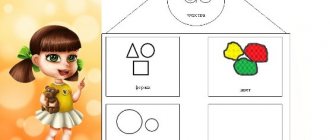Conversation-training on life safety for older preschoolers “Safe behavior on the street”
Conversation-training on life safety
"SAFE BEHAVIOR ON THE STREET"
(senior preparatory group)
Compiled the article. teacher
MBDOU d/s No. 6 (Krupskoy 7)
Khodulina I.N.
Goal:1. Introduce children to the rules of playing in the yard.
2. Discuss various dangerous situations with children. Play out the situation - “game on the sidewalk.”
3. Teach children the necessary precautions. Together, develop rules for behavior on the street and playground.
Hod: Guys, today we will talk about how to behave on the street, where you can and cannot play. Dunno will also participate in our conversation.
-In the evening. When you come home from kindergarten or on weekends, where do you usually go for a walk?
Children: In the yard, in the park, my brother and I go to the next street.
Educator: Where in the yard do you play? What is this place called?
Children: playground.
- Who do you think is doing the right thing (shows posters). Nikita or Yulia?
- Why?
Tell me, is it possible to play on the roadway of the street or yard?
Children: No, you can't.
Educator: Why not?
Well done, I agree with you. Which of you thinks the same as Alina?
Show pictures.
Educator: Look carefully at the two pictures and tell me where the children do the right thing and where they don’t? Why do you think that? Prove it to everyone.
— In the picture on the left, the children are doing the wrong thing because they are playing on the roadway, and in the picture on the right...(correct)
Educator: So, where should we play?
At the playground.
Educator: Remember, guys and you, Dunno, remember the rule: It’s only unsafe to play on the playground
Dunno: If I can’t play on the roadway, I’ll play on the sidewalk.
Educator: Guys, what is a sidewalk?
That's right, it's a walking path for pedestrians, it's a limited space.
Educator: Do you think it is convenient to play on the sidewalk?
Let's try it, let's conduct an experiment.
Game training is carried out with children.
Educator: Go to the carpet.
How can we limit our play sidewalk?
(children offer and limit the edge of the carpet with bricks from the builder).
Educator: The sidewalk has been limited. We will be divided into children who will play on the sidewalk - jumping rope, rolling a car, playing with a ball, and pedestrians - who will walk along the sidewalk in one direction and the other.
Everyone will take a card that will tell them who they will be in the game.
Children take cards (jump ropes, balls, cars, road signs - pedestrians are drawn on them.)
Now take what you need to play.
(Music plays, children play out a problem situation - some play on the sidewalk, others move in opposite directions.)
EducatorL after the game) Was it convenient for pedestrians to walk? Why is it inconvenient? Was it comfortable for you to play? Why?
Please take your seats at the tables.
Educator: So what can we say about playing on the sidewalk?
Tell the dunno.
Children say in turns:
It is inconvenient for children to play on the sidewalk.
There was also little room for pedestrians to pass, everyone was jostling.
Educator: Children, playing on the sidewalk is not only inconvenient, but also dangerous. Why do you think?
Children: the ball can get under the feet of pedestrians and people can fall, the ball can roll onto the road where there are cars. It's dangerous to run after him.
Educator: Correct. Remember. When you and I walked to the stadium, we saw an open hatch. This is very dangerous; you can accidentally fall into it and get injured. Therefore, what should you always be like?
Well done, really, very attentive. If you see an open hatch where repair work is not being carried out, what should you do in such cases - pass by or inform one of the adults about the disorder?
Children: Inform adults about this so that they can close the hatch or fence off the area with a sign.
Educator: Children, what danger can threaten in winter or spring, when the snow melts?
That's right, you can slip, fall, break, and even worse, break your leg.
What danger awaits children who play under the roof of a house on which huge icicles or blocks of snow hang?
Of course, icicles or snow can fall at any time and cause irreparable harm.
We must always remember this, do not forget the rules and place of the game, and be attentive.
Educator: Let's remember, children these rules:
1. Never play on the roadway. Playing on the sidewalk is inconvenient and also dangerous!
2.Play only in the yard, on the playground.
Dunno, always follow these rules and teach them to others.
Educator: Now I want to make sure that all these rules are understood and learned.
(cards on the tables - invites you to look at them, think about whether the children are doing the right thing, and then tell everyone). The time taken is -10 seconds.
Children work in groups of two.
Come out, Yulia and Seryozha.
What's on your card? A boy plays ball on the roadway. Where should I play? ( At the playground)
All children answer this way.
The teacher, together with the children, draws conclusions for each situation.
Educator: Well done! I made sure that you understood and remembered that you need to play in the yard, on the playground, and ride a bicycle or scooter on the sidewalk, and not on the roadway. I hope that you will always follow the rules of safe behavior on the street.
Dunno: And now I will only play according to the rules of safe behavior on the street!
Educator: And now, children, it’s time for us to go for a walk on the playground.
Long-term planning for life safety for the senior group (March, April, May)
Yulia Polishchuk
Long-term planning for life safety for the senior group (March, April, May)
March
Week 1: Work according to traffic regulations
Conversation “Dangerous Crossroads”. D/i "Trip around the city". S/r game "Chauffeurs"
Program content: Expand knowledge about the characteristics of traffic at an intersection; continue to introduce the rules for the movement of pedestrians and cars using a three-color traffic light.
Literature: Polynova V.K. p. 75
Week 2: Fire safety.
Playing out the situation: “There was a fire in the house!” Phone "01". Reading and discussion of I. Tverabukin’s poem “Andreikin’s Watch.” Funny game “The Most Loud One”.
Program content: To teach children, through playing out difficult situations, various ways to get out of them.
Literature: Kolomeets N.V. p. 61
Week 3: Personal safety on the street.” (Not everyone you meet is a dear friend)
Getting to know the rules. Relay race “I’ll run away from someone else”, D/i “Say a word”, D/i “Watch” (description of the person, signs, what he looks like). Reading the fairy tale “Little Red Riding Hood” by Charles Perrault.
Program content: To warn against troubles associated with contacts with strangers; promote the development of caution and prudence; teach children how to behave correctly in a situation of violent behavior by an unfamiliar adult.
Literature: Volchkova V. N. p. 189, Presentation “Personal safety on the street and at home”
Week 4: Personal safety on the street (Continued)
Repetition of home address, full name of parents.
Modeling the situation “They are calling you to the next street...”. "You were treated to a stranger"
Program content: Discuss dangerous situations that may arise when contacting strangers at home; teach the correct behavior in such situations
Literature: Volchkova V. N. p. 189, Presentation “Personal safety on the street and at home”
April
Week 1: Work according to traffic regulations
“Rules of conduct on the railway”, introduction to the rules.
Program content: Formulate rules for safe behavior on the railway; replenish children's vocabulary by speaking with them complex words: locomotive, train, turnstiles, driver, conductor, railroad worker; educate children to be attentive and careful.
Literature: Kolomeets N.V. p. 139, Presentation “For children about the rules of safe behavior on railway transport”
Week 2: Fire safety.
Conversation: “Fire is a friend, fire is an enemy” Actions in case of fire using illustrations and posters.
Looking at illustrations of a fire truck.
Drawing "Fire Truck"
Program content: Teach children to talk about the benefits fire brings to humans; consolidate children's knowledge of what can result from careless handling of fire; know and follow the rules of behavior in case of fire; instill in children respect for the work of firefighters.
Literature: Garnysheva T. P. p. 91, Presentation “About good and evil fire”
Week 3: “Safety when interacting with animals.”
Getting to know the rules. Simulation of the situation “Meeting with a stranger’s dog.” Assignment: remember what the calf Gavryusha did with the postman Pechkin in Prostokvashino. Conversation “Cats can be dangerous too”
Program content: To provide knowledge about the rules of conduct when meeting various pets; teach children to understand the state and behavior of animals, how to communicate with them.
Literature: Volchkova V. N. p. 192, Presentation “Safety rules when communicating with animals”
Week 4: Poisonous mushrooms and plants.
Getting to know the rules. Looking at pictures depicting edible and inedible mushrooms. D/i “Edible - inedible”, “Find mistakes.” Drawing “Draw to remember and not touch!” (Amanita)
Program content: Give an idea of edible and poisonous mushrooms and berries; teach to distinguish mushrooms by pictures and the signs that are given in the riddles and explanations of the teacher.
Literature: Volchkova V. N. p. 198, Garnysheva T. P. p. 39, Presentation “Poisonous Plants”
May
Week 1: Work according to traffic regulations
Communication situation “We are on the street.” Game situations “How do I know the rules of the road.” Illustrations "Situations on the road." D/i "Rules of Conduct".
Program content: Continue to introduce children to what can happen if you go for a walk alone; where you can and cannot play. Literature: Polynova V.K. p. 47, Presentation “Rules of conduct on the road”
Week 2: Fire safety.
A conversation about safety rules in nature during a fire, looking at relevant illustrations. Reading of N. Belyanina’s poems “At leisure, children...”, “From a burning match in the summer...”, conversation on the content. D/i "Fire extinguishing agents"
Program content: Introduce children to the rules of behavior in nature during a fire.
Literature: Volchkova V. N. p. 195, Presentation “Safety rules and behavior in case of fire”
Week 3: “Water Safety”
Getting to know the rules. Looking at illustrations. Reading the poem "The Diver's Tale." Assignment: what rule of behavior on the water was violated by the heroes of S. Marshak’s poem “Three Wise Men in One Basin.”
Program content: To form ideas about the rules of safe behavior near water and on water, about the causes of accidents on water; to develop knowledge about actions in case of danger on the water.
Literature: Garnysheva T. P. p. 40, Presentation “Rules of conduct near bodies of water”
Week 4: “Safety in nature”
Getting to know the rules. Looking at illustrations and pictures.
D/i So – not so.” Simulation of situations “We are in the forest...” S/r game “We are going to the dacha”
Program content: Introduce children to the rules of behavior in nature during a thunderstorm. Give children knowledge about the rules of behavior when meeting different insects.
Literature: Volchkova V. N. p. 195

